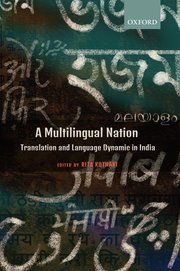Professor Francesca Orsini is the Principal Investigator of the MULOSIGE project, and leader of the North India case study. She is Professor of Hindi and South Asian Literature, as well as Chair of the CCLPS. Her research interests range from modern and contemporary Hindi literature to the multiligual history of literature in early modern North India. Prior to this project, she ran the AHRC-funded “North Indian Literary Culture and History, 1450–1650” (2006–09) and a British Academy-funded international collaboration with SARAI/CSDS on Hinglish (2014–15).
 Na Turk, na Hindu: Shared language, accents and located meanings.
Na Turk, na Hindu: Shared language, accents and located meanings.
In: A Multilingual Nation: Translation and Language Dynamic in India. New Delhi: Oxford University Press.
The chapter “Na Turk, na Hindu: Shared language, accents and located meanings” by Francesca Orsini was published in A Multilingual Nation: Translation and Language Dynamic in India. This book asks whether multilingualism in India to be understood as a neatly laid set of discrete languages or a criss-crossing of languages that runs through every source language and text? The collected chapters combine to argue that translation is not a ‘solution’ to the allegedly chaotic situation of many languages, rather it is its inherent and inalienable part.
Introduction: “Na Turk, na Hindu: Shared language, accents and located meanings”
Modern language ideologies firmly believe that languages “belong” to specific communities, be they ethnic, regional, or religious. These imagined communities, Benedict Anderson has taught us (1991), get simultaneously projected in the past, present, and future. In the late-nineteenth and early-twentieth centuries the slogan “Hindi-Hindu-Hindustan” projected Hindi (in the Nagari script) as the language of Hindus in north India “from the beginning”, urged contemporary north Indian Hindus to embrace it, and claimed that Hindi would become the national language of all Indians, explicitly coded as Hindus. This modern imagination forged a continuum of script-language-community in the face of long histories of multi-scriptual and multilingual practices in which languages have commonly been written in more than one script and people learnt more than one language and knew how to navigate a multilingual social world. As the other essays in this volume make clear, multilingualism in India has not been exclusive to literate elites or embodied in specialists but has permeated every aspect of the social world, from endogamous families to the workings of the bazaar, from local and higher-level administration to the law, from religious preaching to singing and story-telling (Orsini & Schofield 2015). It is flying in the face of this persistent multilingualism that modern language ideologies have carved out separate pasts and futures.


Leave A Comment